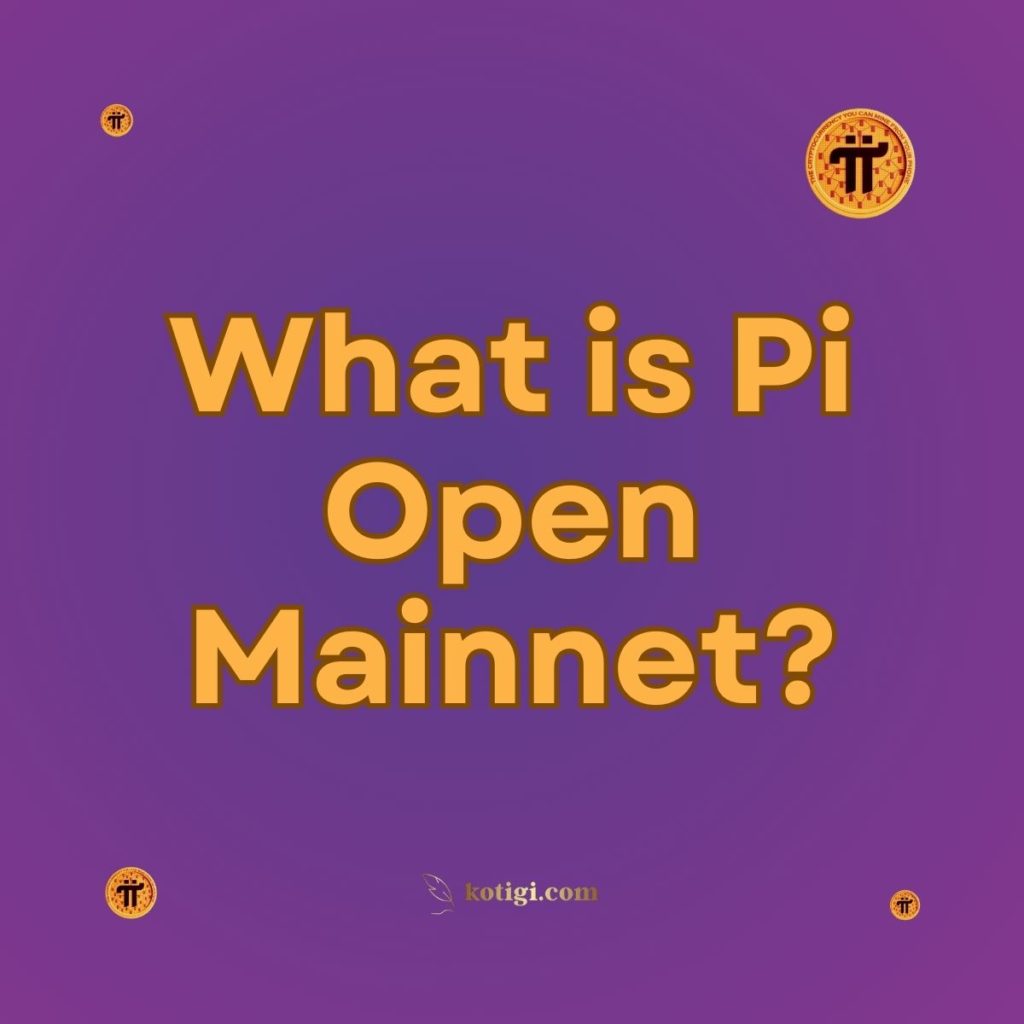
What is Pi Open Mainnet?
Pi Network will officially transition to the Open Network period of Mainnet at 8:00AM UTC on February 20, 2025. Pi Open Mainnet is the phase in the Pi Network’s development when the network transitions from a testnet to a fully operational blockchain platform. It represents a significant milestone that enables Pi coins to be traded, used in transactions, and fully integrated into the blockchain ecosystem. This phase will enhance the network’s functionality and expand its use cases.
Pi users will be able to exchange their Pi coins for fiat money and other cryptocurrencies during the Open Mainnet stage. It also gives developers more freedom to experiment, building services and programs on top of the stable network architecture. When a blockchain protocol is fully established and implemented, it is referred to as the mainnet. At this point, cryptocurrency transactions are broadcast, validated, and recorded on a distributed ledger technology, or blockchain.
The network had three main phases: the Mainnet (from 12/28/2021 to the present), the Testnet (from 3/14, 2020 to 3/14, 2020), and the Bootstrap (from 3/14/2019 to 3/14/2020). In the initial two stages, Pi transfer was typically unavailable throughout the entire network. Individual Pioneers were able to access mainnet migration and transferability during the two phases of the Mainnet phase (the Enclosed and Open Network periods) by completing the methods listed below.
Introduction
Pi Network is an innovative project in the cryptocurrency space, aiming to democratize mining and provide a mobile-friendly approach to digital currency. One of the key milestones in the development of Pi Network is the transition to the Open Mainnet. This phase is crucial as it signifies the shift from a test environment to a fully operational blockchain platform. In this article, we will explore what Pi Open Mainnet is, its significance, the transition process, and its potential impact on the Pi Network ecosystem.
Understanding the Mainnet Concept
What is a Mainnet?
A Mainnet (short for “Main Network”) is a fully functional and operational blockchain network where the cryptocurrency’s transactions and operations are conducted. Unlike testnets, which are used for testing and development purposes, the mainnet is the real blockchain where actual transactions take place, and digital assets hold real value.
Difference Between Testnet and Mainnet
The Testnet and Mainnet serve different purposes:
- Testnet: Used for testing new features, fixing bugs, and ensuring the blockchain’s functionality before it goes live. It operates in a simulated environment and transactions have no real-world value.
- Mainnet: The live blockchain where real transactions occur. It involves actual digital assets, and transactions are recorded on the blockchain, making it a critical phase for the cryptocurrency’s ecosystem.
Overview of Pi Network
Introduction to Pi Network
Pi Network is a cryptocurrency project that aims to make mining accessible through mobile devices. The network was launched to create a decentralized digital currency that can be mined by anyone with a smartphone. Pi Network emphasizes user participation and community involvement, offering a unique approach to cryptocurrency mining.
Key Features of Pi Network
- Mobile Mining: Allows users to mine Pi coins using their smartphones with minimal computational resources.
- Community Focus: Encourages user participation and growth through referrals and community building.
- Decentralization: Aims to create a decentralized network that empowers users and ensures a distributed consensus mechanism.
Transitioning to Open Mainnet
Importance of Open Mainnet
The transition to the Open Mainnet is a critical phase for Pi Network. It signifies that the network is moving from a test phase to a fully operational blockchain platform. This transition is important for several reasons:
- Functionality: It enables Pi coins to be traded and used in real transactions, increasing the network’s utility.
- Value: Users will be able to convert their Pi coins into other cryptocurrencies or fiat currencies, adding real-world value to the coins.
- Integration: The Open Mainnet will allow Pi Network to integrate with other blockchain platforms and services, expanding its ecosystem.
Key Milestones in the Transition
The transition to Open Mainnet involves several key milestones:
- Testnet Phase: Testing and development of the blockchain’s features and functionalities.
- Beta Testing: Limited release of the network for beta testing to identify and fix any issues.
- Mainnet Launch: The official launch of the Open Mainnet, where the network becomes fully operational.
Features and Capabilities of Pi Open Mainnet
Enhanced Functionality
The Open Mainnet will introduce enhanced functionalities to the Pi Network, including:
- Trading Capabilities: Users will be able to trade Pi coins on various cryptocurrency exchanges, allowing for liquidity and exchange between different cryptocurrencies.
- Smart Contracts: The mainnet may support smart contracts, enabling the creation of decentralized applications (dApps) and automated transactions.
- Transaction Processing: Improved transaction processing speeds and capabilities, providing a more efficient blockchain experience.
Increased Security
Security is a critical aspect of the Open Mainnet:
- Decentralized Consensus: The network will rely on a decentralized consensus mechanism to validate transactions and maintain the integrity of the blockchain.
- Enhanced Encryption: Increased encryption and security protocols will be implemented to protect user data and transactions.
- Network Integrity: Continuous monitoring and updates to ensure the network remains secure and resistant to attacks.
User Accessibility
The Open Mainnet will enhance user accessibility by:
- Wallet Integration: Integration with various digital wallets for easier storage and management of Pi coins.
- Exchange Listings: Listing Pi coins on major cryptocurrency exchanges, providing users with more options for trading and conversion.
- User Interface Improvements: Enhancements to the user interface for a more seamless and intuitive experience.
Impact on the Pi Network Ecosystem
Economic Implications
The transition to the Open Mainnet will have significant economic implications:
- Market Value: The value of Pi coins may fluctuate based on market demand and trading activity. The ability to trade Pi coins on exchanges will impact its market price.
- Investment Opportunities: Increased functionality and trading options will attract investors and potential partners, contributing to the network’s growth and development.
- User Incentives: The ability to convert Pi coins into other assets provides users with tangible rewards for their participation in the network.
Community Engagement
The Open Mainnet will impact community engagement in several ways:
- Increased Participation: The introduction of trading and real-world applications will likely increase user participation and involvement.
- Development Opportunities: Developers may create new applications and services based on the Pi Network’s blockchain, expanding its ecosystem and use cases.
- Feedback and Adaptation: User feedback during the Open Mainnet phase will help the Pi Network team address any issues and make necessary improvements.
Network Growth and Expansion
The Open Mainnet will facilitate network growth and expansion:
- Partnerships: Collaboration with other blockchain projects and platforms will enhance the Pi Network’s capabilities and reach.
- Global Adoption: The ability to trade and use Pi coins in various applications will contribute to its global adoption and acceptance.
- Technological Advancements: Continuous development and integration of new technologies will drive the network’s evolution and innovation.
Challenges and Considerations
Technical Challenges
Transitioning to the Open Mainnet involves addressing several technical challenges:
- Scalability: Ensuring the network can handle increased transaction volumes and user activity without compromising performance.
- Interoperability: Integrating with other blockchain platforms and services to provide a seamless user experience.
- Bug Fixes: Identifying and resolving any technical issues that arise during the transition phase.
Regulatory Compliance
Regulatory compliance is a critical consideration for the Pi Network:
- Legal Requirements: Adhering to legal and regulatory requirements related to cryptocurrency transactions and data protection.
- Anti-Money Laundering (AML): Implementing AML measures to prevent illicit activities and ensure the network’s integrity.
- Know Your Customer (KYC): Ensuring compliance with KYC requirements to verify user identities and prevent fraud.
User Adoption
User adoption is essential for the success of the Open Mainnet:
- Education and Awareness: Educating users about the Open Mainnet’s features and benefits to encourage participation and engagement.
- Support and Assistance: Providing support and assistance to users during the transition phase to address any issues or concerns.
- Incentives: Offering incentives and rewards to attract new users and retain existing ones.
Future Prospects for Pi Network
Long-Term Vision
The long-term vision for Pi Network includes:
- Global Integration: Expanding the network’s reach and integrating with global financial systems and services.
- Ecosystem Development: Developing a robust ecosystem of applications and services built on the Pi Network blockchain.
- Sustainable Growth: Ensuring sustainable growth and continued development to maintain the network’s relevance and value.
Potential Use Cases
Potential use cases for Pi Network include:
- Digital Payments: Using Pi coins for digital payments and transactions in various industries.
- Decentralized Applications: Developing dApps and services based on the Pi Network blockchain.
- Investment Opportunities: Offering investment opportunities and financial services based on Pi Network’s ecosystem.
Community and Developer Engagement
Engaging with the community and developers will be crucial for the network’s success:
- Community Feedback: Gathering feedback from users and community members to drive improvements and innovations.
- Developer Support: Providing resources and support for developers to create new applications and services.
Conclusion
The Pi Open Mainnet represents a significant milestone in the Pi Network’s development, marking the transition from a test environment to a fully operational blockchain platform. This phase will enable trading, real-world applications, and expanded functionalities, impacting the network’s value, user engagement, and ecosystem growth. While challenges and considerations remain, the Open Mainnet offers exciting opportunities for the Pi Network and its users, paving the way for future innovations and advancements in the cryptocurrency space.
Key Takeaways:
- Pi Open Mainnet signifies the transition to a fully operational blockchain network where Pi coins can be traded and used in real transactions.
- The transition involves key milestones such as testnet phase, beta testing, and the official mainnet launch.
- Enhanced functionalities, increased security, and improved user accessibility are core features of the Open Mainnet.
- The transition impacts the network’s economy, community engagement, and growth prospects.
- Challenges include technical issues, regulatory compliance, and user adoption, which will be addressed during the transition phase.





